VHF UHF Dxpedition April May 2025
A21TX - V5/ZS4TX - D2TX
Every morning in Africa an Impala wakes up.
It knows it must run faster than the fastest Lion or it will be killed.
Every morning a Lion wakes up.
It knows it must outrun the slowest Impala or it will starve to death.
It does not matter if you are a Lion or an Impala. When the sun comes up, you had better
BE RUNNING!
[African Proverb]
Following a successful 2M EME DXpedition to Angola in August 2022, several requests for another Dxpedition that include 6M, 70CM and 23CM, were received from the EME community. The 6M, 70CM and 23CM bands are not included in the regular Angolan Amateur radio frequency plan, which by default only includes HF and 2M, so I set out to try and get permission to have them included on my licence renewal for the next year.
Following multiple requests to the Angolan regulator, the only allocation where Amateur Radio was allowed on a secondary basis was 70CM. That band was subsequently added to my 2024 licence as well as on the 2025/6 licence renewal. My request for 6M, 23CM and bands used for the QO-100 geostationary satellite was denied.
2024 Passed without an opportunity to do the expedition. The next available window was April and May 2025. The month of April traditionally marks the end of the rain season in Botswana, Namibia and Angola. The chances of still having a possibility of 2M, or even 70CM, trans equatorial propagation [TEP] made it the ideal period to travel. After my wife, Ronél ZS4TZ, confirmed that she will join me on this crazy endeavour, final planning for the expedition was set in motion.
Apart from finding a place in Angola that ticks all the boxes to operate from, traveling there by road from South Africa is not a trivial exercise. The road to the Angolan border from South Africa is either via Botswana and Namibia or only via Namibia on a slightly longer track. The shortest roads are usually in an extremely bad condition for long sections of the road so a round trip that enters Angola at any point usually ends up being close to 7000km. This trip was no different and not without surprises.
The main aim of the DXpedition was to activate 70CM from Angola as it has never been done before. With the limited activity on 70CM EME it made no sense to only concentrate on 70CM, so I decided to include equipment for 6M, 2M EME and the QO-100 geostationary satellite from other locations. The SAT equipment gave me the option to activate a few new grids and further to use as a safety measure where no other forms of communication exist.
The pending peak of Solar Cycle 25 brought renewed interest in VHF/UHF trans-equatorial [TEP] propagation, so I decided to include 2M and 70CM operations from the northern part of Botswana and Namibia as well. This would allow an opportunity for stations that missed the previous Dxpeditions from there. The A21EME operation in 2019 was active on 6M, 2M, 70CM as well the microwave bands via EME. From Namibia the last known EME VHF/UHF/SHF activity was V55EME during 2011.
It therefore made sense to include some EME activity from Botswana and Namibia to give new operators the opportunity to work A2 and V5 as well. The proposed activation from Namibia generated a lot of interest as it has been 14 years since it was last activated. The Botswana interest was not far behind as for some reason no station in North-America [NA] managed to work A21EME in 2019. This time NC1I made sure he was the first one from there in the A21TX 70CM log. Frank also managed to work me in V5 and D2 with his excellent EME station.
On the way to the final stop in Botswana, at Nata Lodge, I set up the QO-100 Satellite station provided by PA3CMC to active the rare KG39 grid square. 150+ stations were worked during this session, all on SSB.
 A21TX KG39 QO-100 Activation
A21TX KG39 QO-100 Activation
We also received notice that the planned accommodation in Angola was no longer reachable due to the heavy rain flooding the Cubango river banks and roads and also damaging the heavy duty barge used to transfer vehicles across it to the Cuatir Nature Reserve.
The Cuatir site ticked all the boxes with an open moonrise and moonset as well as a constant electricity supply and safe accommodation. The option to operate from the 2022 site in Menongue was still available but that would mean a 1800km addition to our trip. Our options were either to stop and return to South Africa to try at another time or to look for an alternative site in Angola.
Stefan van Wyk, the owner of the Cuatir Nature Reserve, then put me in contact with Jeff Foster who farms near Cahama in southern Angola. Jeff offered to host us for a few days and confirmed electricity and accommodation on site. The only issue was that his farmstead is surrounded by tall trees and finding a spot that will be open to moonrise and moonset could be difficult. My wife and I decided to take a chance anyway and we rescheduled some of our planned accommodation bookings on the way to accommodate the additional 700km of travel. The project to do 70CM from Angola was still alive! I then contacted John, ZS6JON who then relayed the changes in schedule on the Moon-Net email reflector.
A21TX Senyayti Lodge KH22dq
The first leg of the trip to Senyati lodge at the top end of Botswana, is a ~1500km trip that took three full days of daylight to drive from my home in Bloemfontein. Free-roaming elephants and other wildlife in Botswana make driving at night very risky. The potholes on some road sections also contribute to a daytime driving only rule. During the last 200km to Senyati Lodge, several elephants and other large animals were encountered on and beside the road. The remains from previous animal and vehicle accidents were visible at several places along the road.
An incident with the Botswana Highway Patrol at Pandamatenga, on the way to Senyati Lodge, left somewhat of a bitter taste on an otherwise wonderful visit to Botswana. Apparently stopping for 0.5 seconds only at a semi-invisible STOP sign is not regarded as a real stop. Fortunately, as is the custom everywhere else in the world, they had their credit card machine with them, and I could pay for my mistake immediately. A quick search on the internet mentioned several previous similar incidents at the same town.
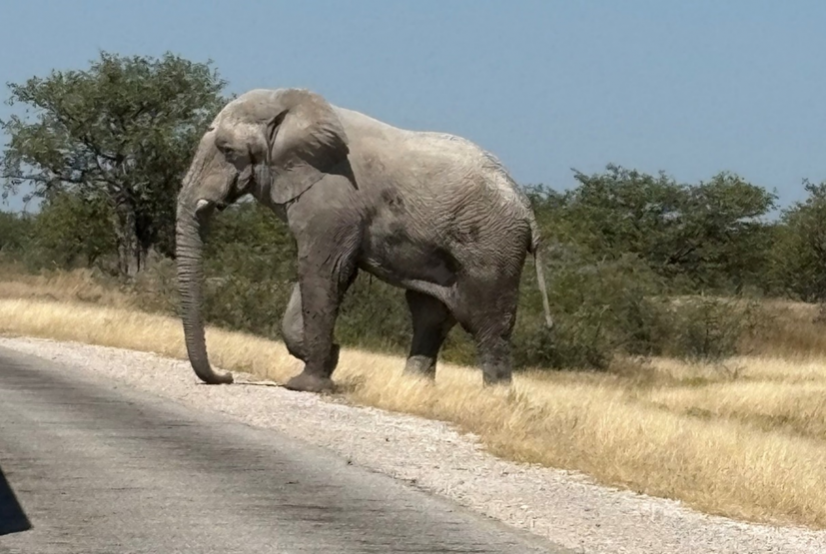
Arrival at Senyati Lodge was around midday on the 23rd of April. Our accommodation only became available at 14:00 local time so I started with the assembly of the mast and antennas next to the bungalow allocated to us. The surprise was that the 2025 rain season lasted longer than usual and I had to stop several times due to heavy rain and thunderstorms that typically lasted 10 to 30 minutes at a time throughout the afternoon.
By nightfall all the equipment was set up and ready to start on 70CM at moonrise the following morning. Further rain and thunderstorms prevented any activity until around 3 hours after moonrise with PA3DZL deservedly being first in the log followed by several other stations from Europa and Japan. Frank, NC1I called in just after his moonrise for the first Botswana to North America 70CM EME contact.
The 25th of April was reserved for a visit to the Victoria Falls about 80km away. The water flow at the falls was at maximum level due to the unusual high level of rain experienced in the Zambian and Angolan catchment area the previous few weeks.
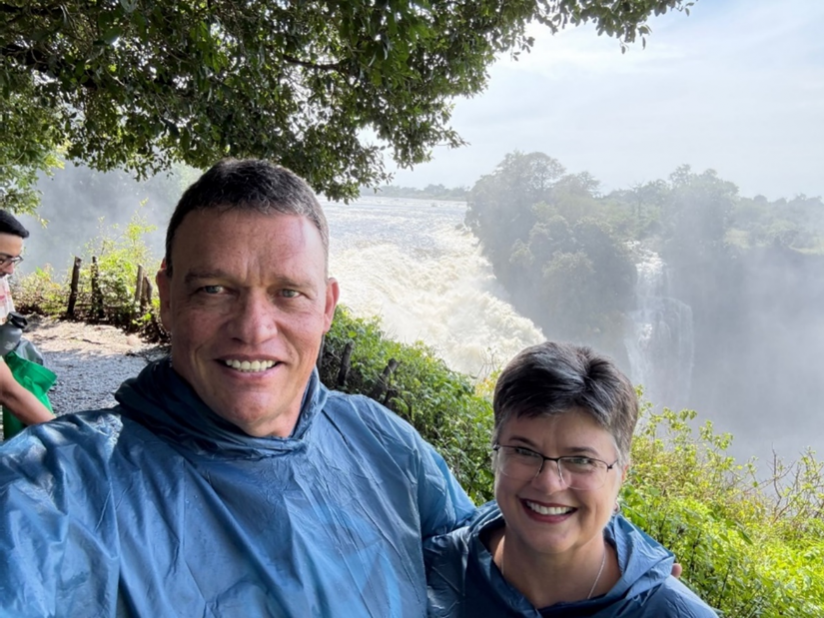
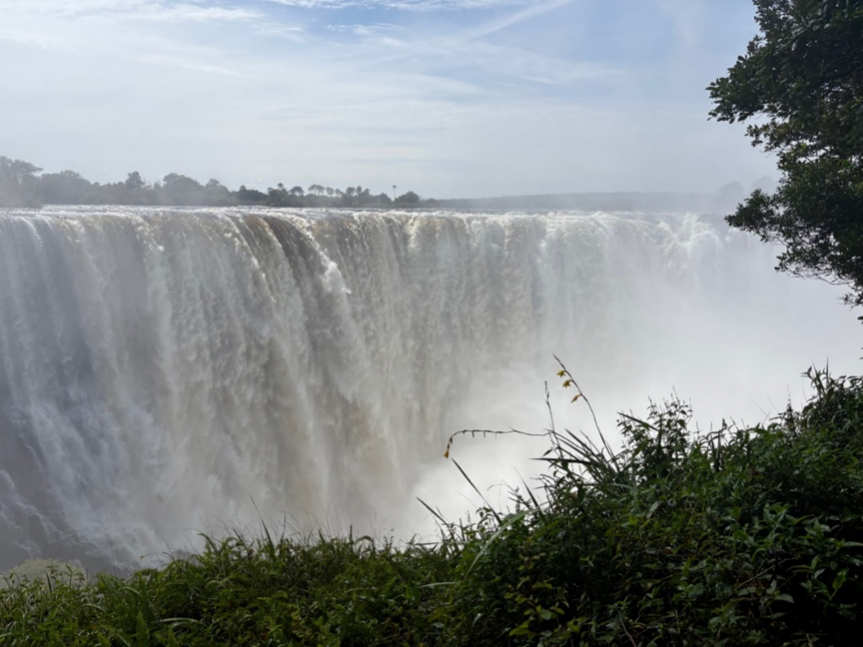 Victoria Falls, Zimbabwe
Victoria Falls, Zimbabwe
On the 26th of April, I connected the 2M equipment and worked 45 stations during that pass, including several that mentioned that A2 was a new entity for them on 2M.
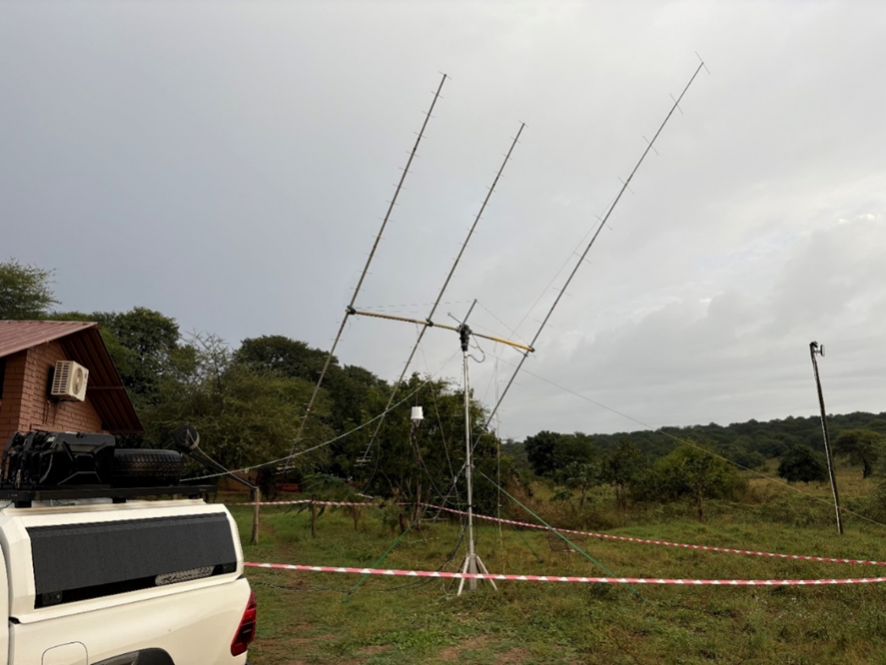 A21TX KH22 Dual Band Array 2M and 70CM
A21TX KH22 Dual Band Array 2M and 70CM
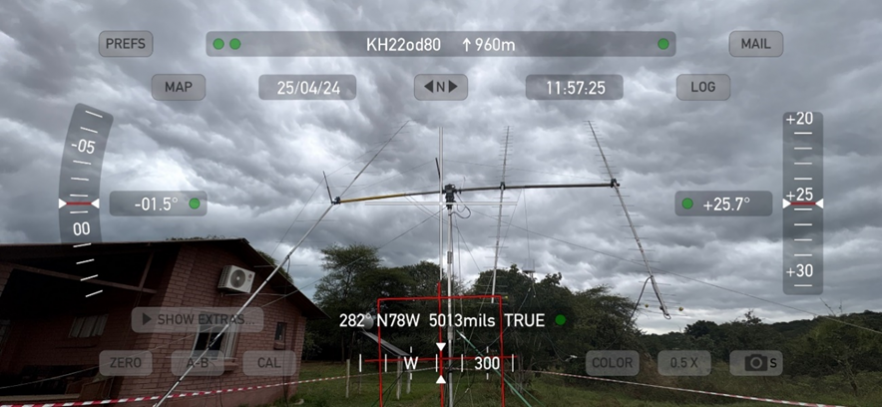 A21TX KH22 - Direction moonset
A21TX KH22 - Direction moonset
From the A21TX antenna installation pictures you will see that the setup consisted of a 4.5M fold-over mast and a Yaesu G5500 Az/El rotator with a single 2M18XXX on the one side and a horizontal stack of 2 x M2 9WL 70CM yagi antennas.
The idea with the dual band array was to allow easy switching between bands to avoid calling CQ for long times on a single band without any callers. The ever-present rain and thunderstorms reduced the time on the moon to such an extent that it was never quiet during the usable EME windows, so my ambitious plan did not really bear fruit.
It was a huge effort to install and keep the dual band array up and working so I decided to be more conservative in Namibia and Angola and only do one band at a time. This would reduce setup time and require less guy ropes to secure the installation. Less cables between the mast and the equipment also made it easier keeping the mosquito’s out of the cable inlets at the window openings.
Not exactly knowing what the conditions at each site would be, I made sure to cover all the options where the equipment could be installed e.g. at the mast, inside the canopy of my pickup truck or inside a building with different options to connect to it for the actual operation. The best option in the end proved to be the equipment inside the canopy and the truck parked as close as possible to the antenna.
This allowed for shorter RF cables and having everything in close view, much easier to maintain full operation. The operating position became the place within Wi-fi range with the least mosquito’s and flies, except during TEP openings where I mostly stood at the radio.
I made use of an Intel 12V NUC pc right at the radio to do all the station functions and with my iPhone or notebook using VNC, I could connect to it either via an on-site access point or directly to it with a 100m LAN cable.
The 2M TEP operation was hampered by a floodlight just north of my antenna setup that affected the ability to receive weak signals. A highlight was that SV2DCD decoded my Q65 signals for a short period although we were unable to make a two-way contact.
 SV2DCD Decoding A21TX on 2M TEP 144.192 Q65B-30
SV2DCD Decoding A21TX on 2M TEP 144.192 Q65B-30
With the antenna setup including 2M and 70CM, I also added a few contacts on the RS-44 LEO satellite with ZS6JON, 3B8FA, ZS6CR, ZS1A and ZS4JAL making it in the log. Stations from Europe were also heard but no contacts were made.
From Senyati Lodge we crossed over to Namibia at the Ngoma border post through the Caprivi strip for a one-night stay-over at Nunda Lodge on the banks of the Okavango River before driving to the first Namibian TEP/EME activation site.
V5/ZS4TX Simanya Lodge JH92
Simanya Lodge is located on the road west of the Cubango River which forms the border between Angola and Namibia for a long stretch towards the east until it crosses the Caprivi strip and enters Botswana to be dissipated in the well-known Okavango Swamps. The Cubango River, after it combines with the Cuito River, is known as the Okavango where it enters Namibia on its way to the Okavango Delta in Botswana.
This lodge was chosen as a stepping stone for the Angola operation as it was the closest lodge to the Angolan border. From here it was still another 160km into Angola to the Cuatir Nature Conservation, a trip that typically takes 6 hours to drive, including a barge assisted river crossing. It was also used for a final equipment checkpoint and to try and work 2M TEP from the northernmost part of Namibia.
Upon arrival at Simanya Lodge, I installed the 2M18XXX on my pickup truck as in the picture below. The moon was already gone so all that remained was to look for a TEP opportunity later the evening. The equipment was all set up in the canopy of my pickup truck, so I had to stand right next to it to operate as the Wi-fi signal was too weak to relay to our room to operate remotely.
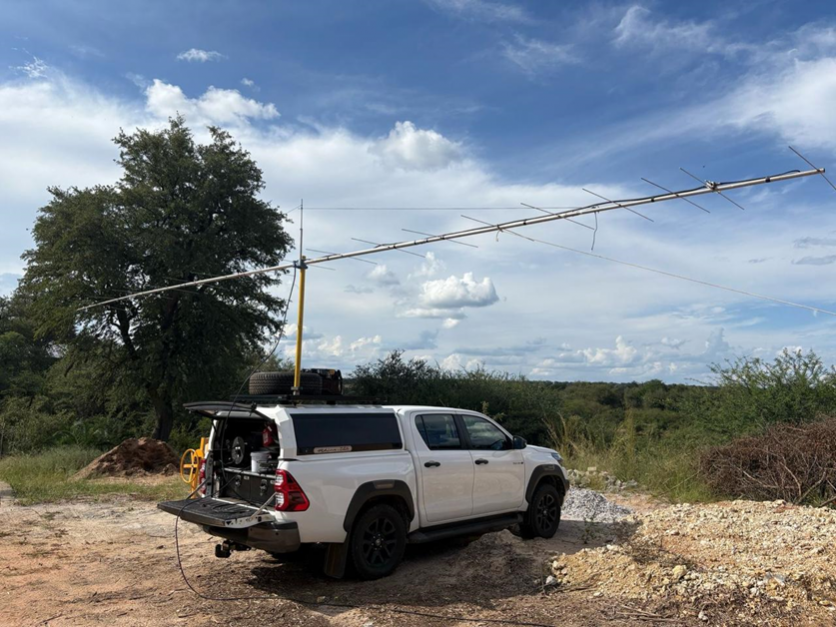 V5/ZS4TX JH92 2M TEP/EME installation with Angola visible across the river to the right of the picture.
V5/ZS4TX JH92 2M TEP/EME installation with Angola visible across the river to the right of the picture.
This minimal antenna configuration would also allow EME contacts during short periods of moonrise and moonset. The moonset direction was slightly blocked due to trees, but moonrise was clear over the Cubango river, just 30m away.
I started to listen and call CQ on 144.192 Q65-30 from 18:00Z onwards and just as I was about to give up and admit defeat to the bugs and mosquito’s at 19:25Z, I heard this strong ominous sounding noise coming from the speaker and IK7UXY was decoded calling me! There was no typical weak-to-stronger signal building. It was just there suddenly and the Aurora distortion on the digital signal was very evident. Only Gianni, IK7UXY made it in the log on the first evening from JH92 but it caused a lot of excitement as no other 2M TEP contacts between EU and AF since 1992 have been reported except for Wynand, V51WW, who has been making regular contacts for the last year or so during the peak TEP periods.
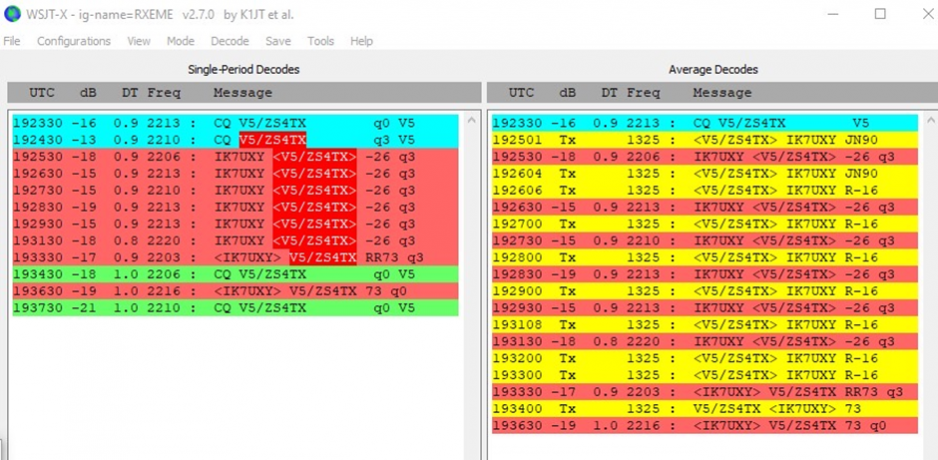
Q65B -30 Signals decoded at IK7UXY via 2M TEP from JH92
The V51WW location was ~170km south of my JH92 setup, and on 28 of April he was not hearing any TEP signals, showing again how reliant TEP is on a good location. Even the Hippopotamus close by on the riverbank was making happy sounds!
During the first moonrise window, my receive capabilities were suddenly way below standard with a constant 10-15dB additional noise. My initial thought was that the electronics in the Toyota pickup was generating the noise so after the moonrise pass, I decided to move the antenna away from the pickup truck to avoid the noise although the noise was not there during the evening TEP window. I had to try something.
I then found a Yellow, manually operated, antenna elevation device next to the buildings and decided to use it as a support for the antenna. I was hoping for a concrete improvement to the receive noise and initial tests showed that the new mounting plan solved the problem, but the noise later returned, and I had to look elsewhere. By chance, I realised that the noise level change when I touched the LNA relay assembly and upon further investigation I found that a short piece of coax cable in the relay assembly developed a bad coax braid connection, probably from the rainy and wet conditions in Botswana.
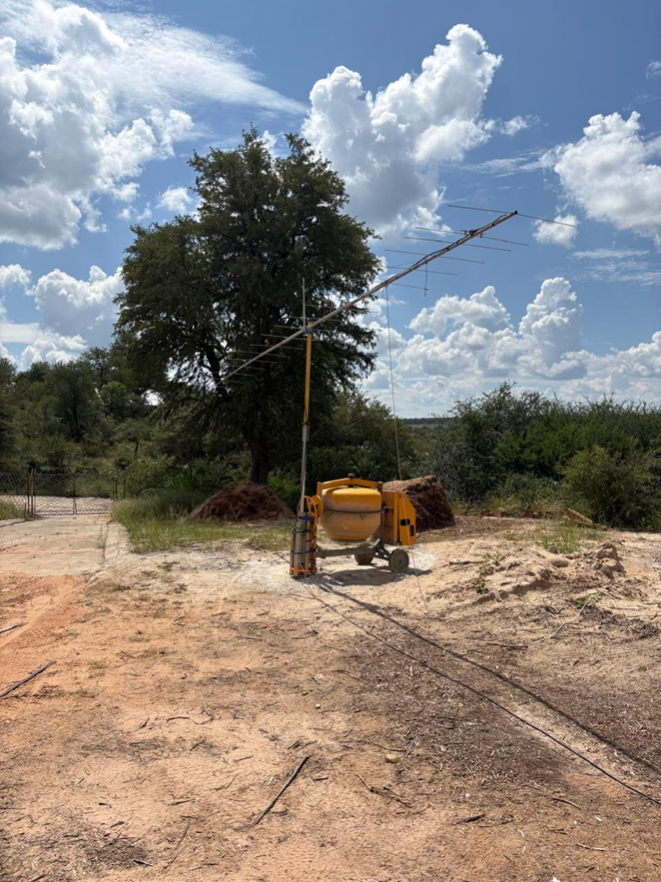 V5/ZS4TX JH92 Alternative 2M Installation
V5/ZS4TX JH92 Alternative 2M Installation
After fixing the LNA relay setup, the receive problem was solved and a few more stations were worked via EME. After moonset, the antenna was pointed north and after quickly working another 130 stations via the QO-100 geostationary satellite, the wait for a TEP opening started.
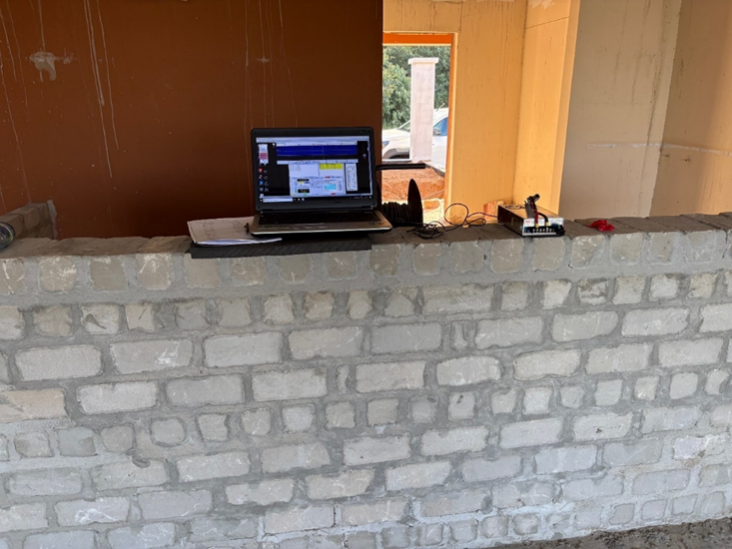 V5/ZS4TX EME and QO-100 operating position
V5/ZS4TX EME and QO-100 operating position
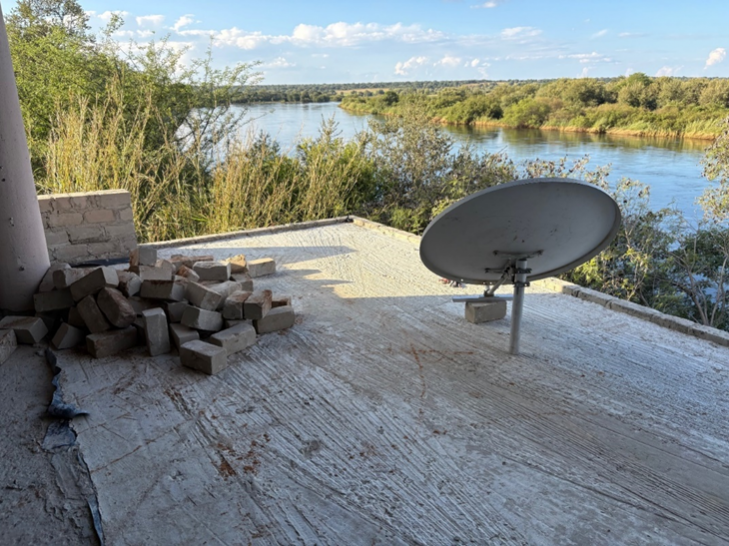 V5/ZS4TX QO-100 dish during installation with Angola visible across the Cubango river
V5/ZS4TX QO-100 dish during installation with Angola visible across the Cubango river
At 17:55Z on the 29th of April the TEP signals started to come through and again, like a switch has been flipped, from nothing to very strong in one 30 second period.
Several callers were noted and IK7EZN, SV2DCD, IW7DLE, I8KPV and IK7UXY [2nd QSO] made it into the log during severely distorted signal conditions. SV2DCD was also worked on SSB with severe Aurora but a strong S9 signal. 9H1PA also reported decoding me at +2 but was not worked due to a faulty antenna configuration on his end.
There were times that the severe distortion of the TEP signals caused a no-decode on the Q65B-30 mode, so experiments were done after the initial contacts using Q65D-30. Better decodes were received on both ends of the TEP circuit during the tests on Q65D. I therefore decided to use Q65D for the Angola TEP operation. On my side using the Icom IC-9700 the decodes also seemed better with the AGC setting on Medium. Most signals were S9 with severe distortion as can be seen on the screenshot of the waterfall below.

After 30 minutes of no new callers, just as I was about to go QRT, I saw a clear signal with very little distortion on the waterfall display from SV1NZX calling me with 50W and a somewhat compromised 9 element Tonna yagi antenna for his first ever 2M TEP contact! Alex, SV1NZX was one of the VHF operators instrumental in setting up a TEP Whatsapp group and motivating people to participate in the project. A well-deserved contact indeed.
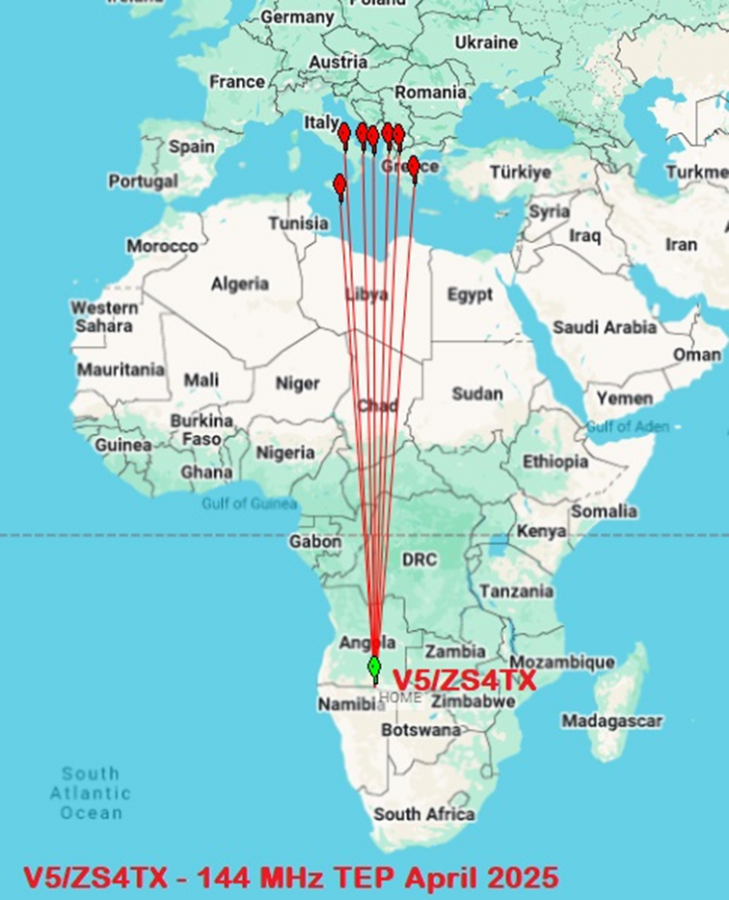 V5/ZS4TX 144 MHz TEP Contacts Map courtesy of SM7LCB.
V5/ZS4TX 144 MHz TEP Contacts Map courtesy of SM7LCB.
The V5/ZS4TX operation from Simanya Lodge was cut short by one day to accommodate the extra day needed to drive to JH74 in Angola. On the 30th we drove to Ondangwa, Namibia, close to Oshikango, where we would be crossing the Namibia/Angola border the following day.
D2TX JH74 Chimbemba
The border crossing at Oshikango/Santa Clara was less eventful compared to the crossing we experienced in 2022 at the Katwitwi border post where we were delayed for 2 hours having to unpack and explain everything. A busier border port has some advantages.
After a three-hour drive into Angola to Cahama, our host Jeff, met us at the turn off to the Cahama airport and we followed him for another 85km on a two-track sandy road, taking us two additional hours, to the farmstead, arriving at around 13:00Z. This left little time to offload, determine the best location for moonrise, moonset and TEP and do the first installation.
The only position that would work the best to cover most of the requirements was about 80 meters away from a power source and still had some tree blockage towards moonrise which would be fatal on 70CM. With no other options, I proceeded with the installation in the 35C heat, drinking Liters of water and applying mosquito repellent like it was going out of fashion. At the time, Southern Angola was experiencing a high volume of Malaria cases, and I did not want to take any chances.
My own two AC leads connected in series just made up the ~80 metres of cable required to supply the equipment located inside the canopy of the pickup truck, close to the antenna.
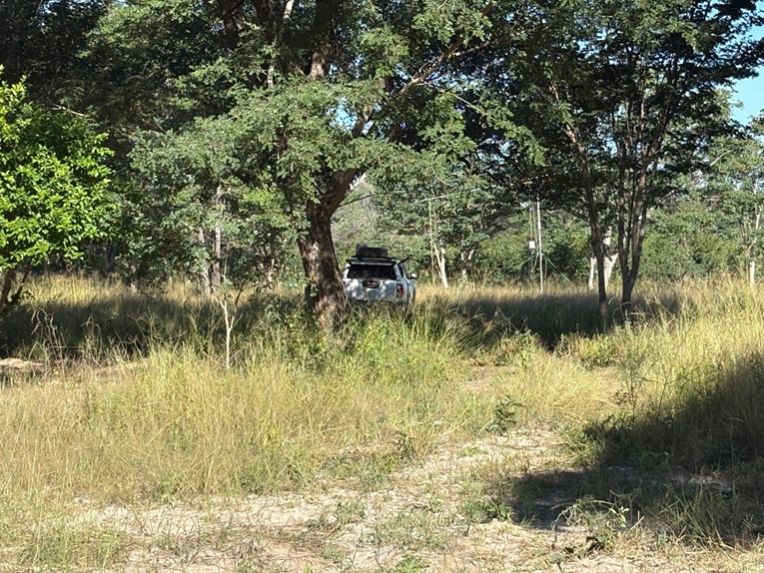 D2TX JH74 Operating site in the Angolan bush
D2TX JH74 Operating site in the Angolan bush
On 1 May 2025 at 16:00Z, just before sunset, I was ready for the first attempt at 2M TEP from Angola. Exactly like from JH92 in Namibia, the opening occurred suddenly with huge S9+ signals coming in from Italy and Malta. IZ8EDJ, 9H1PA, I8KPV, IZ0UME, IK0SMG, IK7EZN, I8IGS, IK7UXW and SV2DCD were logged within the first 20 minutes using Q65D. With the S9+ signals, SSB was very possible, so I changed to SSB and worked 9H1TX as well as 9H1PA. Interestingly enough, 9H1TX had more distortion on his signal than 9H1PA even though they are close to each other. Both were using 4 x10 element arrays but Philip, 9H1PA had a clear path to the south while David, 9H1TX, running more power, had some residential building obstruction towards Africa.
Recordings of some of the TEP SSB contacts can be heard here:
Costas, SV1DH, a veteran from the Africa to Europe TEP tests 45 years ago, was also decoded very well at D2TX but unfortunately no two-way contact was made.
The TEP signals disappeared at 20:00Z and I took the opportunity to test the last few degrees of my moonset via 2M EME. SM5KWU, IK2DDR and I3MEK was worked from 3 degrees down to right to 0 degrees. I now had confidence in the moonset as there was minimal tree blockage in this general direction.
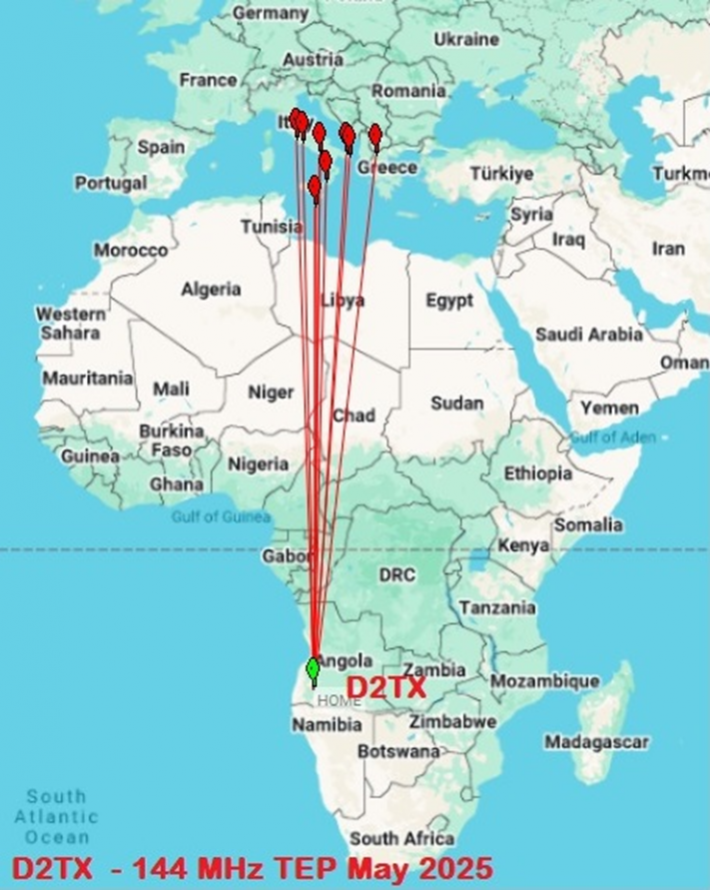 D2TX 144 MHz TEP Contacts Map courtesy of SM7LCB
D2TX 144 MHz TEP Contacts Map courtesy of SM7LCB
Moonrise the next day was no different with G3SWX coming in strong right after moonrise followed by PA3DZL. The full moon pass included another 75 stations worked with many claiming a new DX entity and some celebrating a new grid locator having worked me before in 2022 from a different grid.
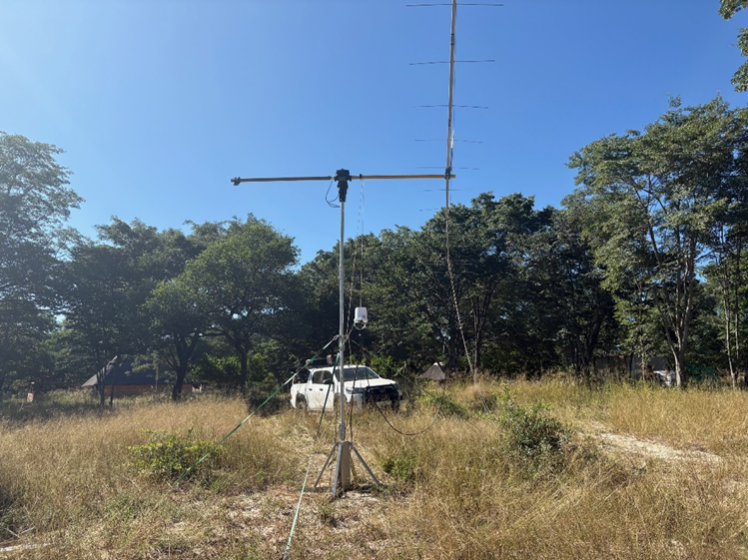 D2TX JH74 2M Antenna - 2M 18XXX
D2TX JH74 2M Antenna - 2M 18XXX
The 3rd of May was dedicated to the main purpose of the whole trip which was to activate Angola on 70CM EME for the first time ever. The whole morning was spent taking down the 2M antenna and moving it to the short mast located on the pickup truck’s canopy so that it can be used on TEP with the 2nd radio, an IC-705, while also being active on 70CM EME.
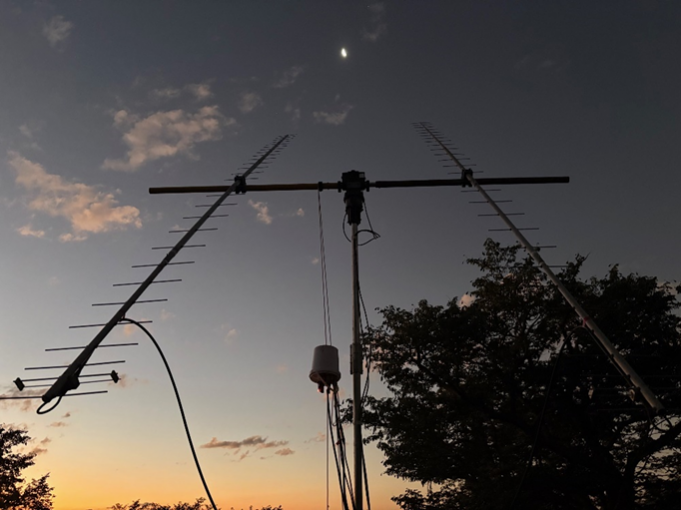 D2TX JH74 70CM Antenna Array
D2TX JH74 70CM Antenna Array
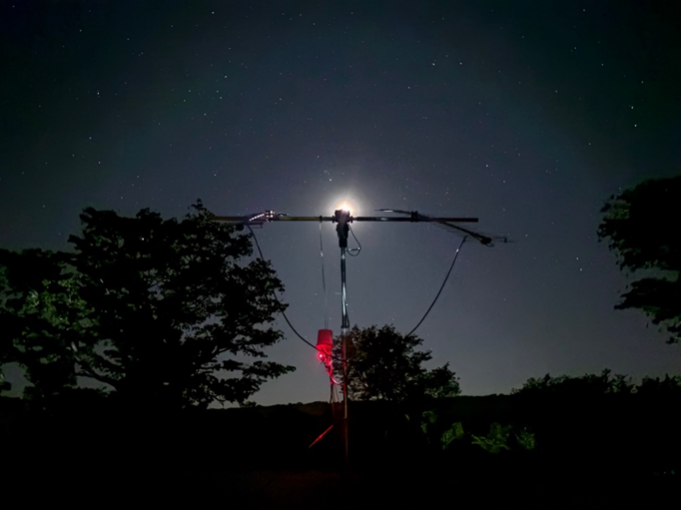 D2TX JH74 70CM Array - approaching moonset
D2TX JH74 70CM Array - approaching moonset
The slightly lower declination for this day meant that the Moonrise could be more obscured than on the previous day. That proved to be the case as the first station was only decoded at 18 degrees elevation when the Moon cleared the treetops. Guy, ON4AOI was the first in the D2TX 70CM log. A total of 45 stations were worked during the moon pass with Ian, W6TCP being the last caller as the antenna was approaching some blockage again at 10 degrees before moonset. Other firsts were: OK1VUM, GD0TEP, SM4GGC, HB9Q, PA3CMC, UT5DL, JG6CTK, DK3WG, YL2GD, OH6UW, UA3PTW, G4RGK, NC1I, ZS6JON, S57Q, GW4ZHI, OZ9AAR, VK2CMP and F1RJ.
During the moon pass, the G-5500 and ERC-M controller was showing erratic values on the Azimuth indicator, and I had to recorrect the direction several times until I realised that the voltage drop on the long extension leads was causing this. Our host had two different AC solar installations and initially we were on the smaller one, so he offered to move our supply point to the bigger plant which added another 2 x 5 metres of extension leads but the problem was solved with at least 160V AC reaching the equipment.
After a while, running with the extended lead setup, my wife alerted me that she saw fire coming from one of the plug joints. Subsequently, the connecting plug of one of the new leads, caught fire and was busy melting. The connection was quickly bypassed by Jeff, our host, and the operation continued.
As can be seen from the pictures below, showing the approximate moonrise and moonset paths, the margin for a large change in declination was small without having a dedicated moonrise or moonset installation.
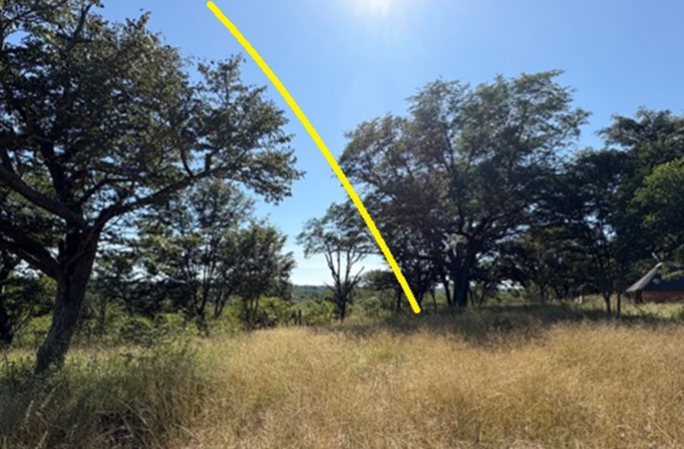 D2TX Moonrise direction 2 May 2025
D2TX Moonrise direction 2 May 2025
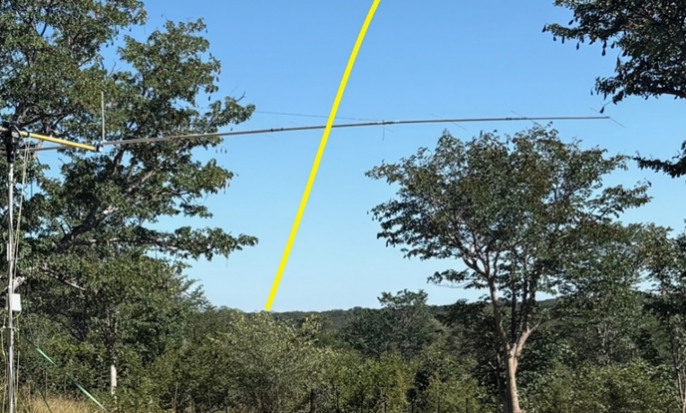 D2TX Moonset direction 2 May 2025
D2TX Moonset direction 2 May 2025
No 2M TEP signals were detected during the evening of the 3rd of May 2025. Several EU stations were on standby on 70CM as well in case we had a good 2M TEP opening again. Unfortunately, that did not happen as we were already on the end of the regular TEP season where contacts can be made almost daily if you are in the right location.
The 4th of May was spent taking the station down and packing for the seven-hour trip south to Ondangwa in Namibia.
V5/ZS4TX Ongava Lodge JH70
After a full rest day, we slowly cruised through the well-known Etosha Game Park and at midday on the 6th reached Ongava Lodge where Derek, V51DM was our host for the next four days.
Derek is well known on Amateur Radio as well as in the Wildlife Conservation and Travel Industry. His residence at Ongava Lodge is located within the wildlife resort and visits from Lions and Elephants are a regular occurrence. Fortunately, the house and surrounding area are well fenced but checking on the antenna at midnight with Lions roaring within 20 metres on the other side of the fence was a new experience for me!
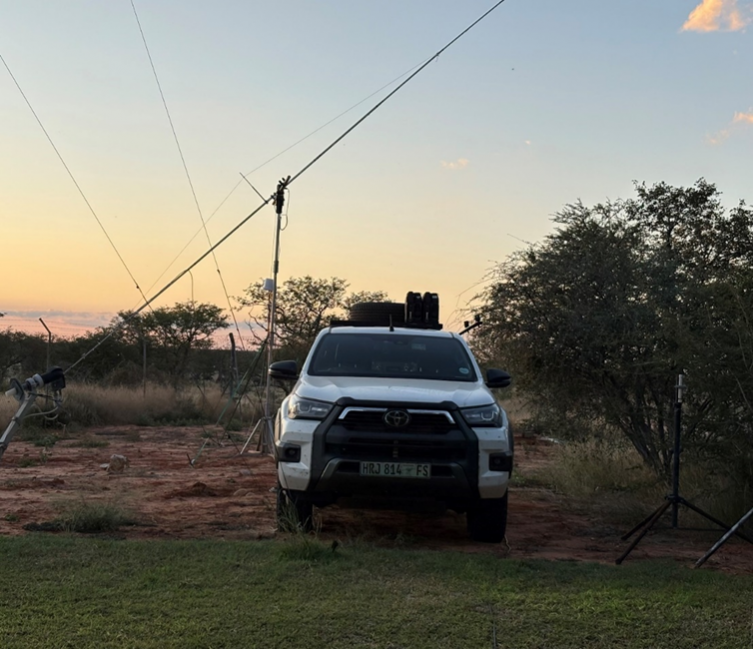 V5/ZS4TX 2M Antenna
V5/ZS4TX 2M Antenna
The 6th and 7th of May was used on 2M EME and around 80 stations made it in the log with several of the old-timers stating that it was a new one for them. The 2M band was also checked for further TEP openings but nothing was detected. With the Moon declination moving further south, there were times that the reflector of the long 2M18XXX antenna was scraping on the ground whilst fully elevated but that did not seem to affect the SWR or caused a noticeable reduction of signal levels.
The complete station was installed in the canopy of the pickup truck and with a decent Wi-fi connection at the Lodge, I was able to operate the station remotely, even on my cell phone, sitting at the campfire and barbeque whilst working EME and viewing the wildlife visiting the waterhole close to the house. DX will never be the same after this one!
The morning of 8 May was used to take the 2M yagi down and install the 70CM array. The moonrise was again obscured by about 20 degrees but at 15:03Z VK2CMP was in the log and 50 other stations followed during the pass with W6TCP and NN3Y making it into the log just as the moon was going down.
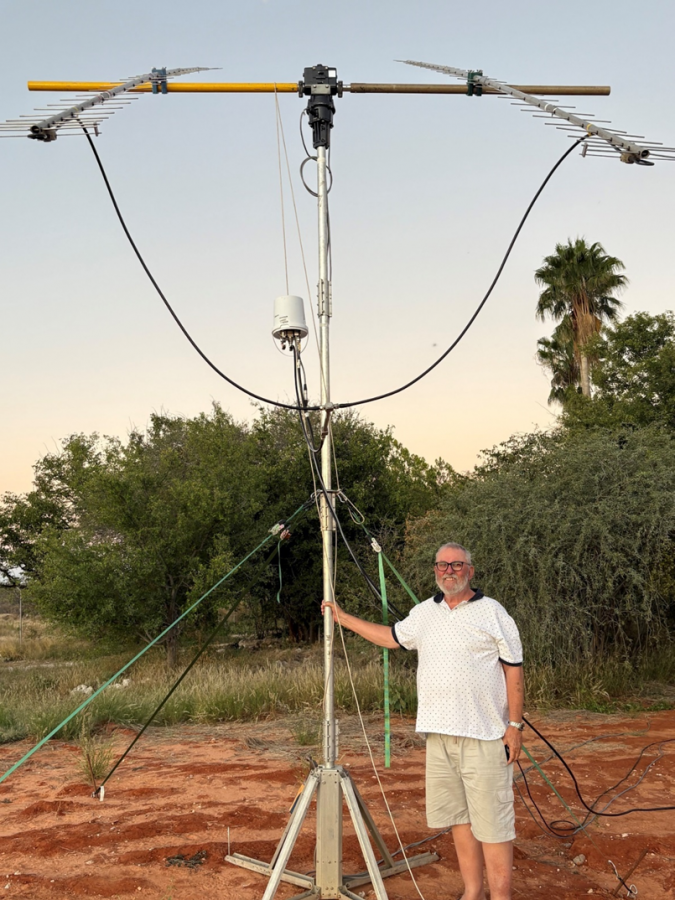 Derek, V51DM at the 70CM array.
Derek, V51DM at the 70CM array.
On the last day of our visit my wife and I spent time viewing the rest of the Lodge areas as well as the Ongava Research Centre, where amazing scientific wildlife and nature research is being done.
Thank you to Derek and the staff at the lodge that made our visit an experience to remember!
The five day, 2500km trip back home commenced on the 10th of May. In total, the trip was just over 7000km.
The expedition was made possible with contributions from the following individuals: V51DM, ZS4TZ, PA2V, PA3CMC, ZS6JON, W6TCP, NC1I, PA3DZL, DL1VPL, SM0KAK, PA0BAT, YO4GJH, VK2CMP, GD0TEP, CT1FCX, F2CT, OE3NFC, G4SWX, K6UFO, OH4LA, PA5Y, JH0BBE, PA3FYC, SV8CS, PA3FWV, DK3WG, ON7EQ, OE3JPC, DF2ZC, IZ8EDJ, OZ9AAR
Club/Organisations: DXNews, SARL [South African Radio League]
Author Bernie Van Der Walt, ZS4TX.


